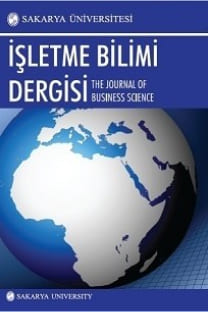Borsa İstanbul’da Yerli Yatırımcı ile Toplam Yatırımcı Arasındaki Nedensellik İlişkisi
Toda-Yamamoto Nedensellik, Granger Nedensellik, Borsa İstanbul
Causality Relationship Between Domestic Investor and Total Investor in Borsa Istanbul
Toda-Yamamoto Causality, Granger Causality, Borsa Istanbul,
___
- Arora, Ravinder Kumar (2016). The Relation Between Investment of Domestic and Foreign Institutional Investors and Stock Return in India. Global Business Review, 17(3), 654-664.
- Balat, Asuman (2020). Türkiye’nin Hisse Senedi Piyasası ile Yerli ve Yabancı Yatırımcı Risk İştah Endeksi İlişkisi: Eşbütünleşme ve Nedensellik Analizi, Erciyes Üniversitesi Sosyal Bilimler Enstitüsü Dergisi, XLIX, 162-171.
- Bozkurt, İbrahim (2016). Yerel Hisse Tercihi ve Bedava Binici Sorunu Etkisi Temelinde Yerli ve Yabancı Yatırımcı Etkileşiminin Tespiti. Sosyal Bilimler Dergisi, 48, 254-271.
- Bulut, Erol & Çoşkun, Çağrı (2015). Doğrudan Yabancı Sermaye Yatırımların Yerli Yatırımlar Üzerine Etkileri: Türkiye Uygulaması. Niğde Üniversitesi İktisadi ve İdari Bilimler Fakültesi Dergisi, 8(4), 1-27.
- Chen, Li-Wen, Johnson, Shane A., Lin, Ji-Chai & Liu, Yu-Jane (2009). Information, Sophistication and Foreign Versus Domestic Investors’ Performance. Journal of Banking and Finance, 33, 1636-1651.
- Demirez, Dilara & Kandır, Serkan Yılmaz (2020). Risk İştahının Pay Getirileri Üzerindeki Etkisinin İncelenmesi. Çukurova Üniversitesi Sosyal Bilimler Enstitüsü Dergisi, 29(4), 92-102.
- Fettahoğlu, Sibel (2019). Relationship Between Credit Default Swap Premium and Risk Appetite According to Types of Investors: Evidence from Turkish Stock Exchange. Muhasebe ve Finansman Dergisi, 84, 265-278.
- Kahneman, Daniel & Tversky, Amos (1979). Prospect Theory: An Analysis of Decision under Risk. Econometrica, 47(2): 263-291.
- Liu, Ningyue, Bredin, Don, Wang, Liming & Yi, Zhihong (2014). Domestic and Foreign Institutional Investors’ Behaviorin China, The European Journal of Finance, 20:7-9, 728-751.
- Markowitz, Harry (1952). Portfolio Selection. The Journal of Finance, 7(1), 77-91.
- Samarakoon, Lalith P. (2009). The Relation Between Trades of Domestic and Foreign Investors and Stock Returns in Sri Lanka. Journal of International Financial Markets, Institutions & Money, 19, 580-861.
- Saraç, Taha Bahadır, İskenderoğlu, Ömer & Akdağ, Saffet (2016). Yerli ve Yabancı Yatırımcılara Ait Risk İştahlarının İncelenmesi: Türkiye Örneği. Sosyoekonomi, 24(30), 29-44.
- www.mkk.com.tr, Erişim Tarihi: 20.02.2021
- Yayın Aralığı: Yılda 3 Sayı
- Başlangıç: 2013
- Yayıncı: Sakarya Üniversitesi
BAĞIMSIZ DENETİM SÜRECİNİN İÇ ve DIŞ DENETÇİ İŞ BİRLİĞİ AÇISINDAN DEĞERLENDİRİLMESİ
Özen AKÇAKANAT, Oğuzhan ÇARIKÇI
ÇEVRİMİÇİ SATIN ALMA KARARINA TÜKETİCİ DEĞERLENDİRMELERİNİN ETKİSİ
Kahraman ÇATI, Hatice İLHAN KÜÇÜK
Siber Suçların Siber Saldırılara Maruz Kalan Şirketlerin Hisse Senedi Fiyatları Üzerindeki Etkileri
Barış AKSOY, Necati Alp ERİLLİ
Borsa İstanbul’da Yerli Yatırımcı ile Toplam Yatırımcı Arasındaki Nedensellik İlişkisi
DIŞ TİCARET SERMAYE ŞİRKETLERİNİN MİSYON VE VİZYON BEYANLARINA YÖNELİK BİR İÇERİK ANALİZİ
KRİPTO PARA BİRİMLERİ ARASINDAKİ FREKANS ALANLI NEDENSELLİK İLİŞKİNİN ANALİZİ
Sınıflandırma Değiştirmesi Kullanılması Yoluyla Kâr Yönetimi ve Denetim Kalitesi Arasındaki İlişki
AİLE ŞİRKETLERİNDE SÜRDÜRÜLEBİLİRLİK AÇISINDAN MUHASEBE VE RAPORLAMANIN ÖNEMİ: ÖRNEK OLAYLAR
